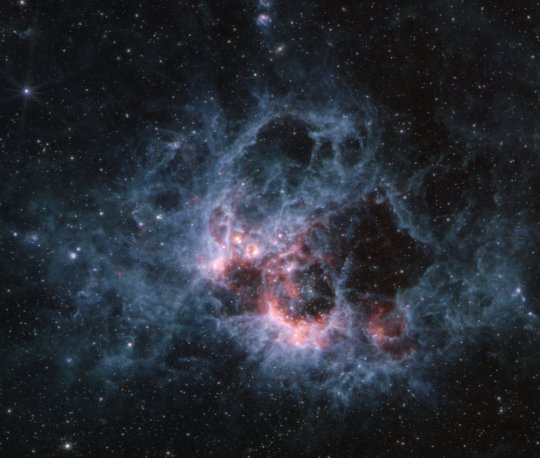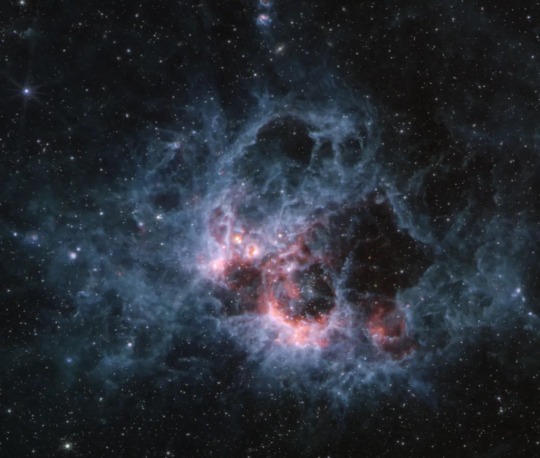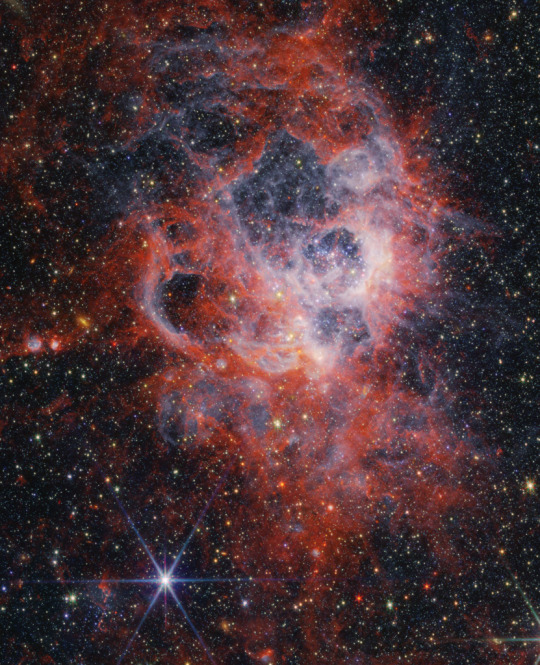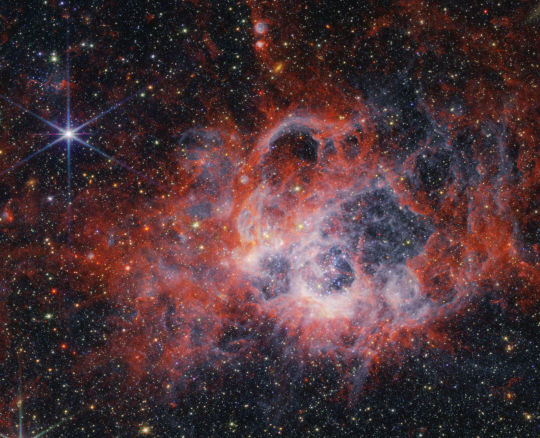#NGC 604
Explore tagged Tumblr posts
Text


Peering Into the Tendrils of NGC 604 l Webb
#ngc 604#triangulum galaxy#space#astrophotography#astronomy#webb#james webb space telescope#solar system#stars#night#planets#sky#universe#nasa
899 notes
·
View notes
Text
Tendrils of NGC 604
The James Webb Space Telescope’s NIRCam and MIRI capture the star-forming region NGC 604. What beautiful images!

NIRCam View

MIRI View
Full NASA article
v v v
#astronomy#nasa news#nasa#nasa photos#james webb space telescope#nircam#miri#ngc 604#space news#space#m33#galaxy#nebula#astronomy news#astrophotography
42 notes
·
View notes
Photo

NGC 604 (center) in the Triangulum Galaxy (M33) // Jeffbax Velocicaptor
Fun fact: NGC 604 is over 40 times the size of the Orion Nebula, and if placed at the distance of the Orion Nebula, it would outshine Venus!
#astronomy#astrophotography#nebula#emission nebula#star-forming region#NGC 604#galaxy#spiral galaxy#star-forming galaxy#messier#messier 33#M33#NGC 598#triangulum galaxy#triangulum
225 notes
·
View notes
Text
2 notes
·
View notes
Text

i frickin love space
#fun fact i didn’t have my paints on my at the time so i had to manually place every star#it was fun#my art#space#nebulae#space art#alcohol markers#i used ngc 604 as a vague reference but it really doesn’t look anything like it
23 notes
·
View notes
Text

NGC 604, Star Nursery
978 notes
·
View notes
Text

Peering Into the Tendrils of NGC 604 with NASA's Webb by NASA's James Webb Space Telescope
418 notes
·
View notes
Text

Peering Into the Tendrils of NGC 604 With NASA’s Webb
171 notes
·
View notes
Photo

2024 November 28
NGC 206 and the Star Clouds of Andromeda Image Credit & Copyright: Roberto Marinoni
Explanation: The large stellar association cataloged as NGC 206 is nestled within the dusty arms of the neighboring Andromeda galaxy along with the galaxy's pinkish star-forming regions. Also known as M31, the spiral galaxy is a mere 2.5 million light-years away. NGC 206 is found at the center of this sharp and detailed close-up of the southwestern extent of Andromeda's disk. The bright, blue stars of NGC 206 indicate its youth. In fact, its youngest massive stars are less than 10 million years old. Much larger than the open or galactic clusters of young stars in the disk of our Milky Way galaxy, NGC 206 spans about 4,000 light-years. That's comparable in size to the giant stellar nurseries NGC 604 in nearby spiral M33 and the Tarantula Nebula in the Large Magellanic Cloud.
∞ Source: apod.nasa.gov/apod/ap241128.html
47 notes
·
View notes
Text

NGC 604: Giant Stellar Nursery in M33 - August 16th, 1996.
"The nebula cataloged as NGC 604 is a giant star forming region, 1500 light years across, in the nearby spiral galaxy M33. Seen here in a snapshot by the Hubble Space Telescope, over 200 newly formed, hot, massive stars are scattered within a cavern-like, gaseous, interstellar cloud. The stars irradiate the gas with energetic ultraviolet light, stripping electrons from atoms and exciting them - producing a characteristic nebular glow. The details of the nebula's structure hold clues to the mysteries of star formation and its effect on the evolution of galaxies."
50 notes
·
View notes
Text
No info for this week's post, at least not in regards to the date it was uploaded or any description. The file did have a high saturation low quality image of NGC 604, which is cool. I thought it was more artwork, like what accompanied Spectral Machine a few weeks ago.

#lost media#circa 2012 (i'm guessing)#song progressions#god i hope ves is a space nerd#and he didn't use 2012 google to search up “nebula”#new life goal is to excitedly scream at ves about nebulae and find out which is his favorite#i have a good feeling about it#stars/heaven/night come up a bit in st's lyrics
39 notes
·
View notes
Text
NASA's Webb Telescope just dropped this INSANE image of a star-forming region called NGC 604
March 9, 2024, NASA's Webb Telescope just dropped this INSANE image of a star-forming region called NGC 604, located a whopping 2.73 million light-years away in our neighboring Triangulum Galaxy (aka M33)!

Want to dive deeper? Check out the full article ➡️ https://www.jameswebbdiscovery.com/discoveries/james-webb-telescope-sheds-light-on-the-chaotic-cradle-of-stars-in-ngc-604
#JWST #NASA #Space #Stars #NGC604 #TriangulumGalaxy #StarFormation #Cosmology #Astrophysics #Science #Astronomy #Universe #Exploration #Learning #Knowledge
#JWST#NASA#Space#Stars#NGC604#TriangulumGalaxy#StarFormation#Cosmology#Astrophysics#Science#Astronomy#Universe#Exploration#Learning#Knowledge
39 notes
·
View notes
Text

The Triangulum Galaxy, M33 // Angelos Kechagias
Seen here zoomed-in, the Triangulum Galaxy contains numerous star-forming regions within it (colored red and pink in this image). These are just like the nebulae in our own galaxy!
The brightest is NGC 604 (left). It is over 40 times the size of the Orion Nebula, and over 6,300 times more luminous than the Orion Nebula. In fact, if it were placed at the distance of the Orion Nebula, it would outshine Venus in our skies!
#astronomy#astrophotography#messier marathon#galaxy#spiral galaxy#star-forming galaxy#triangulum galaxy#messier#messier 33#M33#NGC 598#triangulum
38 notes
·
View notes
Text

Finale got around to processing the photos of M33 I had taken at the end of august. M33 is a spiral galaxy about half the size of our own galaxy and located about 2.7 million light years from earth. This galaxy has a rather high rate of star formation resulting in numerous ionised hydrogen regions (the red irregular blotches inside the galaxy), some of those being notable enough to have been included in the NGC catalogue or the IC catalogue.


NGC 588 NGC 604 (Example of some of the notable nebula in M33)
On of the first recorded observation of this galaxy was possibly done by Giovanni B. Hodierna before 1654, it was independently rediscovered by Charles Messier in 1764 who added it to his catalog (hence the name Messie 33).
information on the photo - total exposure time : 1h48 min using RGB and Ha filters - camera : ASI294 mm - telescope : Newtonian 150/600 with 0.95x coma corrector - photo edited with pixinsight
For those using PixInsight for treatment/edition, I recently discovered the scrips created by Seti Astro (https://www.setiastro.com/pjsr-scripts), Blemish-Blaster was quite useful to remove the halos from my Ha filter and What's In My Image helped with the identification of nebulas. If you had not heard those scrips, you should check them out.
#astrophotography#astronomy#space#galaxies#Messier 33#m33#triangulum galaxy#photos taken from my backyard
18 notes
·
View notes
Text
NGC 604: Dev Yıldız Doğumevi
Günün Astronomi Görseli 25 Nisan 2024 Görsel: NASA, ESA, CSA, STScI Yaklaşık 3 milyon ışık yılı uzaklıkta, yakındaki spiral galaksi M33‘ün kollarında yer alan dev yıldız doğumevi NGC 604 yaklaşık 1300 ışık yılı genişliğinde. Bu, Dünya gezegenine en yakın büyük yıldız oluşum bölgesi olan Samanyolu’nun Orion Nebulası’nın neredeyse 100 katı büyüklüğünde. Aslında, Yerel Grup galaksileri içindeki…

View On WordPress
9 notes
·
View notes
